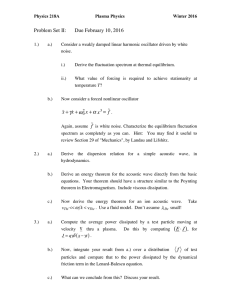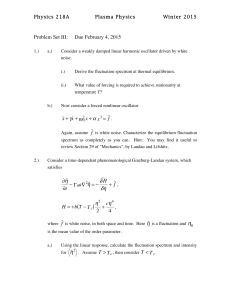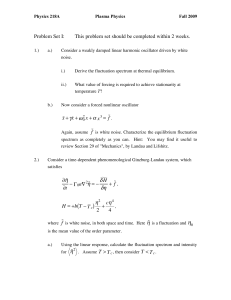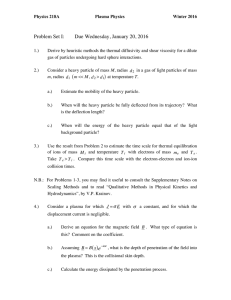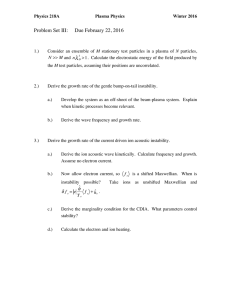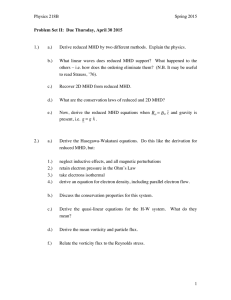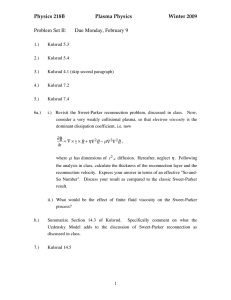Problem Set IV: Due Wednesday, March 9, 2016
advertisement
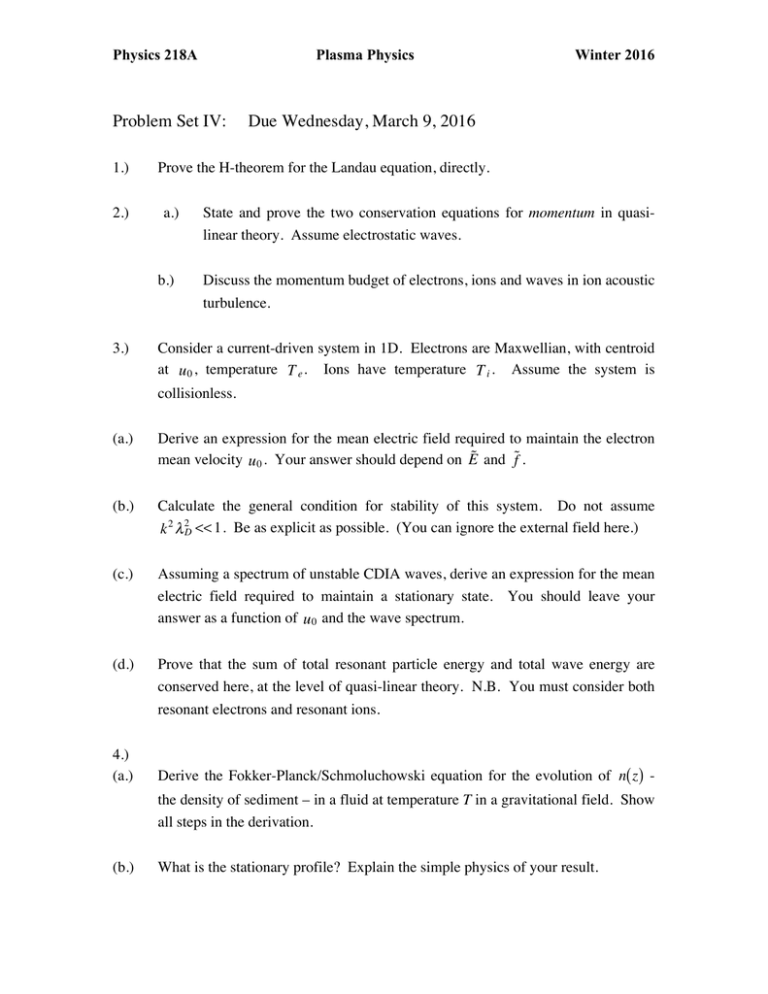
Physics 218A Plasma Physics Problem Set IV: 1.) 2.) Due Wednesday, March 9, 2016 Prove the H-theorem for the Landau equation, directly. a.) b.) 3.) Winter 2016 State and prove the two conservation equations for momentum in quasilinear theory. Assume electrostatic waves. Discuss the momentum budget of electrons, ions and waves in ion acoustic turbulence. Consider a current-driven system in 1D. Electrons are Maxwellian, with centroid at u 0 , temperature T e . Ions have temperature T i . Assume the system is collisionless. (a.) Derive an expression for the mean electric field required to maintain the electron mean velocity u 0 . Your answer should depend on E˜ and f˜ . (b.) Calculate the general condition for stability of this system. Do not assume k 2 λ 2D << 1 . Be as explicit as possible. (You can ignore the external field here.) (c.) Assuming a spectrum of unstable CDIA waves, derive an expression for the mean electric field required to maintain a stationary state. You should leave your answer as a function of u 0 and the wave spectrum. (d.) Prove that the sum of total resonant particle energy and total wave energy are conserved here, at the level of quasi-linear theory. N.B. You must consider both resonant electrons and resonant ions. 4.) (a.) Derive the Fokker-Planck/Schmoluchowski equation for the evolution of n( z ) the density of sediment – in a fluid at temperature T in a gravitational field. Show all steps in the derivation. (b.) What is the stationary profile? Explain the simple physics of your result. Physics 218A 5.) Plasma Physics Winter 2016 Derive an equation for the relaxation of the mean electron distribution f by Coulomb collisions with electrons and ions using a Fokker-Planck approach. You may find it helpful to consult Chapter 8 of Kulsrud. In particular: (a.) Why is a Fokker-Planck approach valid? (b.) Derive Kulsrud Eqns. 18-20. (c.) Derive Kulsrud Eqns. 34, 35, 36. (d.) Derive Kulsrud Eqn. 40. (e.) Show your result is equivalent to the Landau collision integral derived in class. 6.) Derive the relaxation equation for a stable plasma near equilibrium. Consider electrons, with ions appearing via the dielectric. Calculate the correlator: q Eδ f m by decomposing δ f = f c + f! , where f c is the linear response and f! is discreteness. Use Poisson’s equation to relate f c to f! , and take and treat f! (1) f! ( 2 ) as in our discussion of thermal equilibrium. (a.) Derive the expression for ∂ f ∂t . (b.) Compare and contrast this with the Landau equation. (c.) What happens in 1D, for an electron-ion plasma? Explain your result. You may find it useful to consult the notes labeled “Chapter 2”, posted under Supplementary Material. Physics 218A 7.) Plasma Physics Winter 2016 A spectrum of density perturbations with wave vector q and frequency Ω scatter a population of Langmuir waves. Assume Ω << ω pe and q < k , where k is the Langmuir wave vector. (a.) Assuming the plasma waves are initially beamed in the x̂ direction, calculate the time required to isotropize the beam by scattering. (b.) How does the Langmuir wave energy density evolve during scattering? What determines the direction (in scale) in which energy is scattered? What of momentum density? (c.) Assume now that the density perturbations are due to acoustic waves. Interpret the result of part b.) by deducing force must be added to the ion momentum equation in order to conserve energy with the Langmuir waves. Can you deduce the underlying physics here? 8.) Read and summarize the article “Violent Relaxation”, by D. Lynden-Bell, posted in Supplementary Material. Answer the following: (a.) What is the basic idea here? Relaxation”? (b.) In simple terms, why does Lynden-Bell choose Fermi-Dirac statistics? (c.) What is the origin of irreversibility here? How is this reconciled with the fact that the Vlasov equation conserves entropy? (d.) Prove Kelvin’s Theorem for an isotropic fluid and a Vlasov plasma. (e.) What is the relation between a Jeans marginal phase space hole and a relaxed state? What does Lynden-Bell mean by “Violent Physics 218A Plasma Physics Winter 2016 9.) Read the article “A Perturbation Theory for Strong Plasma Turbulence”, by T.H. Dupree, posted in Supplementary Material, and write a short summary. Answer the following. (a.) What is the essential idea of this paper? (b.) How are perturbed orbits treated? (c.) What new velocity and time scales are introduced? Where do they fit relative to familiar scales from QLT? (d.) Why is the resonance broadening cubic in time? Give a simple physical reason. (e.) How does resonance broadening affect quasilinear diffusion?
